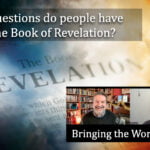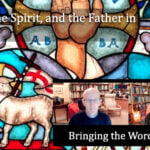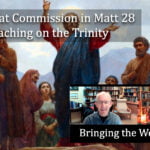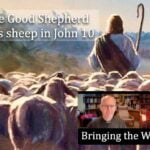 I am writing a commentary on the Book of Revelation, and also doing work on the contribution of Revelation to our understanding of the Trinity. I post hereby summary comments on Revelation 4 and 5, since these are the most important contributions in Revelation to our understanding of the relation between Jesus and the Father, and they make startling implicit claims.
I am writing a commentary on the Book of Revelation, and also doing work on the contribution of Revelation to our understanding of the Trinity. I post hereby summary comments on Revelation 4 and 5, since these are the most important contributions in Revelation to our understanding of the relation between Jesus and the Father, and they make startling implicit claims.
Following the opening greetings and visionary experience of chapter 1, the messages in chapters 2 and 3 looked less apocalyptic and more recognisable as imperial edicts, though with clear connections with what had gone before and anticipations of what is to come later in Revelation. Now, at the start of chapter 4, there is a dramatic change, and it begins to look like a fully-fledged apocalyptic vision, with John embarked on a heavenly journey and reporting what he sees.
There are obvious contrasts here with what has preceded in the messages. The particular circumstances in the messages give way to a picture painted in grands sweeps across a cosmic canvas. The specifics of time and place fade into the timelessness of God enthroned over all creation. And the variety of challenges and responses facing the different assemblies across the cities gives way to a united scene of praise by both God’s people and God’s creation.
Yet in other ways the vision that unfolds is the answer to all the questions and issues raised up till now, and the picture of the power and majesty of God sets the wider context that all the followers of Jesus need to see as their own. Why worry about temporary opposition, either from Jews or pagans, if God is truly enthroned and all-powerful? Why compromise with surrounding culture when the patterns of authority there are just a shadow of the reality of God’s authority? And why falter and stumble if this vision represents your inheritance and your destiny?
Despite the generalities of the vision, they are still expressed in particular language which has a traceable background in two major directions. The first is that of the Old Testament scriptures; John hardly deploys an idea or an image that does not have some Old Testament background, at times from multiple part of the canon of scripture. But this is never done slavishly; the language and ideas are always interpreted and adapted to describe this unique and integrated visionary experience. The second source is that of Roman imperial honour and ‘worship’; we will find that ideas and practices from the wider world are threaded in and out of the Old Testament language.
Together, this blending of ideas and language in John’s description of his divine encounter creates a dazzling vision that fully engages the imagination to its limits. (Detailed comment verse by verse follows here.)
John here offers a dazzling vision of God which pushes the boundaries of human imagination in its metaphorical description. John’s own language reflects this; in contrast with what has come before, he now repeatedly reaches for ‘as’ and ‘was like’ and ‘had the appearance of.’ As elsewhere in Scripture, literal description of God is not possible; God is unknowable even though he has graciously revealed himself to us. Even John’s grammar appears to reflect this; the throne itself is described without using finite verbs, and all in the nominative case, but when John turns to the things around the throne, he moves into the accusative case. Even if some features of this heavenly scene can be described as objects that John can see and apprehend, the throne and the one seated there are not objects to be perceived and analysed.
Yet within this kaleidoscope of language, two threads are clearly woven into the visionary fabric. The first—the warp threads which give structure—is the Old Testament theology of God as the supreme creator and the source of all there is. We see this in the image of the rainbow and in the living creatures, as well as the acclamations of worship; Revelation stands in continuity with the scriptural understanding of God as creator and the repeated re-emergence of that theme in the life of his people and their encounters with God in the different stages of their pilgrimage. This transforms not only our understanding of God, but also our understanding of the world. It is neither an accident of self-generation to be trivialized, nor a resource to be exploited, but an expression of the creative love of God which continually points to it source. And if God is creator of the world, he is also the creator of his own people, and so they owe him not only glory and honour but also gratitude and allegiance.
The second thread—the weft, woven in out of the warp threads—is the imagery of imperial obeisance. Whatever honours and acclaim are given to those with human power—whether it is the wearing of white, the prostration, the casting of crowns, the cry of ‘worthy’—they really belong to God, since the power that is being recognized is power that is God’s power which he shares. Jesus’ words to Pilate ‘You have no power except what has been given to you from above’ (John 19.11) are, refracted through this visionary lens, spoken to all human power. Power that demands allegiance over against or ahead of the God and Father of the Lord Jesus Christ is speaking a lie and based on deceit; if we are tempted to believe it, we need our eyes opened to the true source of all things. God alone is worthy of our unceasing praise, our unswerving loyalty and our profound gratitude.
If the previous scene in chapter 4 was one of dazzling splendour, then its development so far in chapter 5 is one of astonishing drama. The appearance of the scroll causes John to be overcome with grief and frustration; here before him, it seems, is the mysterious will of God for his creation, and yet it remains a mystery—firmly and decisively sealed, so that no-one is able to read it and make sense of it. Yet almost immediately another figure appears in the drama, the lion who looks like a lamb. Nowhere in the text of Revelation is the lamb explicitly identified with the figure of Jesus (itself remarkable), but there is no doubting the identification from both the theological and the textual parallels. Here is the one who fulfils the hopes of God’s people Israel, as the promised anointed Davidic king who was to come. Here is one who is fierce and powerful enough to conquer their enemies, and tear them apart. And yet when John sees him he is like a weak and vulnerable lamb who has been slaughtered, just as the Passover lamb eaten by the people, the suffering servant who was ‘wounded for our transgressions’ and the lamb offered as an atoning sacrifice. He is the one who was slain, but now stands, and shares the throne with God, and with him sends the Spirit to enact his will on earth. Here we have the most explicit (and perhaps the most complex) Trinitarian statement in the whole New Testament. John expresses his theological understanding by the juxtaposition of a series of (sometimes sharply contrasting) images. How we relate and resolve these images—especially the contrast between the lion and the lamb, images of power and weakness, of victory and suffering—will be key to our reading of the whole book. (Detailed comment verse by verse follows here.)
The language of worship here does a remarkable thing in identifying the lamb as equal with the one on the throne in deserving of worship and adulation—in a text which implicitly refutes the claims of the human figures to be deserving of such obeisance. Because of this, it is reasonable to claim that it offers us the highest possible Christological understanding in the whole New Testament: what we can say of God in worship, we can say of Jesus. The two figures of the one seated on the throne and the lamb are thus characterised as God the creator and God the redeemer. These figures are never quite merged, and remain distinct within the narrative of Revelation and, unlike the association of the Word with the work of creation in John’s gospel, their roles also remain distinct. But in the final hymn of praise, the worship is given to the two as if they were one.
The placing of these scenes of heavenly worship following on from the royal proclamations to the assemblies in the seven cities has a powerful rhetorical impact. The followers of Jesus might be facing particular challenges and opportunities, located within their own cultural and physical contexts—yet the context for all their struggles is this cosmic vision of the praise of God and of the lamb. Where they might feel as though they are ‘swimming against the tide’ in terms of dissenting from the cultural norms of their society—in their participation in the trade guilds with their associated deities, in their moral stance, and in their reluctance to participate in the imperial cult—the juxtaposition of chapters 4 and 5 offers a startling reconfiguration of their world. All of creation is caught up, not in obeisance to the emperor, but in the worship of the God and Father of Jesus, and of the lamb, and any who are not taken up with this are, in fact, in the minority. It is an extraordinary cultural and spiritual counter-claim to the majority perception of reality. And in its emotive extravagance, this vision of worship is not offered as a rational fact, but as a compelling call for all readers to join in themselves.
It is also important to note that, whilst there are elements that look to the future restoration and recreation of the world, this is primarily a vision of how things are now, and a reality in which readers can participate now, as an anticipation of the reality that all will one day see clearly.
Follow me on Twitter @psephizo. Like my page on Facebook.
Much of my work is done on a freelance basis. If you have valued this post, would you consider donating £1.20 a month to support the production of this blog?




























I’m delighted, Ian, that you are writing a commentary on Revelation – I certainly need more help to understand this enigmatic apocalyptic. I recently was in Rev4 and delighted to see the Trinity clearly presented: v1 Jesus at the door to heaven inviting John to “Come”; v2 The Spirit then taking John into the throne room and beholding v3 The Father seated on the throne in glory.
Hi! My comment is in contrast to the major teaching of this text. There are two thrones in the Bible: the One of Rev 4&5 and the other one of Isaiah 14. Concerning the former, One is seated holding a scroll and non in heaven or on earth or under the earth can break the seven seals of this scroll. Then from the midst of the throne, and of the four living creatures and of the twenty four elders, stood the Lamb. You assert that the Father and the Lamb are not QUITE merged. Here I disagree. The Lamb could not be seen by John before His standing up ONLY because He was IN the Father. If He were near the Father, John could have seen Him earlier. Therefore trinity is a lie that takes me to the next throne.
The occupant of this second and false throne has fallen from heaven: Isaiah 14:12. His name is Lucifer. He has said in his heart that he will make his throne above the stars of God and that he will be LIKE the Most High. He acknowledges the true throne but still goes a head to create a counterfeit throne here on earth.
I think that your reference in this text is the second throne of the enemy of God; Satan/Azazel.
Thanks, but I don’t think I understand why you say that the lamb was *in* the Father and so couldn’t be seen. One of the features of the heavenly visions in Revelation is that John adds new details at each stage, with no suggestion that things he mentions later are ‘hidden in’ what he described before. And he clearly talks of the lamb and the One on the Throne *both* as separate agents, acting in their own right, *and* as merged characters acting as one.
I am new to this forum and – frankly – new to the subject of interpreting Revelation. I am doing a little bit of research on it – and would greatly appreciate some guidance –
The Lamb of God image – a lamb standing with marks of being slain and carrying a banner – I believe represents the Church Triumphant – of the three states of the Church (along with Militant and Penitent). Or – does this symbol stand for all three states of the Church?
And does this symbol specifically allude to Revelation 5? If anyone knows what I am talking about – thoughts, guidance greatly appreciated!!
My understanding is that the symbol of the lamb only very obliquely refers to the church. It is primarily an image of Jesus (as Lord of his church) and yes, it does com from Rev 5!
If you are new to Revelation, you might be interested in my Grove booklet https://grovebooks.co.uk/products/b-28-how-to-read-the-book-of-revelation
or my commentary, which is quite accessible. https://www.amazon.co.uk/Revelation-Introduction-Commentary-Tyndale-Testament/dp/178359344X
What difference does the shorter ending of Rev 5:14 make to the claim that both God and Jesus receive worship? This verse is the only one in this section with the word “worshipped” although there is much description of worship. I understand the later texts have more, saying who was worshipped – the one on the throne, which I hope doesn’t exclude the Lamb, since I think somewhere it says they share the throne? I’d be grateful for your comments as I’m currently discussing these things with a Jehovah’s Witness. Thank you